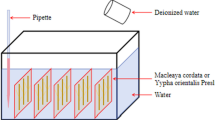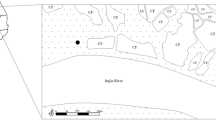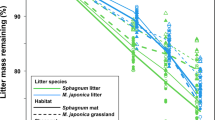Abstract
Radionuclide contamination of ecosystems is a commonly known problem for many sites. A frequently used option in dealing with such contamination is phytoremediation. But when thinking of phytoextraction measures, the process of radionuclide enrichment in plant material is not terminated at the end of the growing season, but may increase during decomposition of the litter afterwards. We show that the process of litter decomposition may be mostly important in remediation of radionuclide-contaminated sites for both aquatic and terrestrial ecosystems. Radionuclide concentrations within organic soil/sediment layers increase strongly during decomposition in terrestrial ecosystems as well as in aquatic systems of temperate zones although there are large differences. This is attributed to emerging fixation sites where differences in aquatic and terrestrial systems are dependent on the particular chemistry (e.g. redox chemistry) of the radionuclides. The potentially high accumulation in developing layers of organic matter on the soils/sediments of aquatic/terrestrial ecosystem can easily be removed from the contaminated sites by removing the organic matter. In summary, beside autochthonous processes (e.g. phytoremediation), especially allochthonous processes (e.g. litter decomposition) are very important for the remediation of radionuclide-contaminated sites.
Access this chapter
Tax calculation will be finalised at checkout
Purchases are for personal use only
Similar content being viewed by others
References
Agapkina GI, Tikhomirov FA, Shcheglov AI, Kracke W, Bunzl K (1995) Association of Chernobyl-derived Pu-239+240, Am-241, Sr-90 and Cs-137 with organic matter in the soil solution. J Environ Radioact 29:257–269
Ahearn GA, Duerr JM, Zhuang Z, Brown RJ, Aslamkhan A, Killebrew DA (1999) Ion transport processes of crustacean epithelial cells. Physiol Biochem Zool 72:1–18
Alves LC, Borgmann U, Dixon DG (2009) Kinetics of uranium uptake in soft water and the effect of body size, bioaccumulation and toxicity to Hyalella azteca. Environ Pollut 157:2239–2247
Amiard JC, Amiard-Triquet C, Barka S, Pellerin J, Rainbow PS (2006) Metallothioneins in aquatic invertebrates: their role in metal detoxification and their use as biomarkers. Aquat Toxicol 76:160–202
Baalousha M, Kammer FVD, Motelica-Heino M, Baborowski M, Hofmeister C, Le Coustumer P (2006) Size-based speciation of natural colloidal particles by flow field flow fractionation, inductively coupled plasma-mass spectroscopy, and transmission electron microscopy/X-ray energy dispersive spectroscopy: colloids–trace element interaction. Environ Sci Technol 40:2156–2162
Barka S, Pavillon JF, Amiard JC (2001) Influence of different essential and non-essential metals on MTLP levels in the Copepod Tigriopus brevicornis. Comp Biochem Physiol C: Toxicol Pharmacol 128:479–493
Barka S, Pavilion JF, Amiard-Triquet C (2010) Metal distributions in Tigriopus brevicornis (Crustacea, Copepoda) exposed to copper, zinc, nickel, cadmium, silver, and mercury, and implication for subsequent transfer in the food web. Environ Toxicol 25:350–360
Barth A, Jurk M, Weiss D (1998) Concentration and distribution patterns of naturally occurring radionuclides in sediments and flood plain soils of the catchment area of the river Elbe. Water Sci Technol 37:257–262
Bastow J (2012) Succession, resource processing, and diversity in detrital food webs. In: Wall DH, Bardgett RD, Behan-Pelletier V, Herrick JE, Jones TH, Ritz K, Six J, Strong DR, van der Putten WH (eds) Soil ecology and ecosystem services. Oxford University Press, New York
Berg B, McClaugherty C (2008) Plant litter. Springer, Berlin
Berg B, Ekbohm G, Soderstrom B, Staaf H (1991) Reduction of decomposition rates of scots pine needle litter due to heavy-metal pollution. Water Air Soil Pollut 59:165–177
Borgmann U, Couillard Y, Doyle P, Dixon DG (2005) Toxicity of sixty-three metals and metalloids to Hyalella azteca at two levels of water hardness. Environ Toxicol Chem 24:641–652
Breitburg DL, Sanders JG, Gilmour CC, Hatfield CA, Osman RW, Riedel GF, Seitzinger SP, Sellner KG (1999) Variability in responses to nutrients and trace elements, and transmission of stressor effects through an estuarine food web. Limnol Oceanogr 44:837–863
Bunzl K, Trautmannsheimer M (1999) Transfer of U-238, Ra-226 and Pb-210 from slag-contaminated soils to vegetables under field conditions. Sci Total Environ 231:91–99
Bunzl K, Kracke W, Schimmack W (1992) Vertical migration of Pu-239+Pu-240, Am-241 and Cs 137 fallout in a forest soil under spruce. Analyst 117:469–474
Bunzl K, Forster H, Kracke W, Schimmack W (1994) Residence time of fallout Pu-239+240, Pu-238, Am-241 and Cs-137 in the upper horizons of an undisturbed grassland soil. J Environ Radioact 22:11–27
Bunzl K, Kracke W, Agapkina GI, Tikhomirov A, Shcheglov AI (1998) Association of Chernobyl derived Pu-239+240, Am-241, Sr-90 and Cs-137 with different molecular size fractions of organic matter in the soil solution of two grassland soils. Radiat Environ Biophys 37:195–200
Cain DJ, Luoma SN, Wallace WG (2004) Linking metal bioaccumulation of aquatic insects to their distribution patterns in a mining-impacted river. Environ Toxicol Chem 23:1463–1473
Cannon HL (1960) Botanical prospecting for ore deposits. Science 132:591–598
Chamberlain PM, McNamara NP, Chaplow J, Stott AW, Black HIJ (2006) Translocation of surface litter carbon into soil by Collembola. Soil Biol Biochem 38:2655–2664
Chavez-Crooker P, Garrido N, Pozo P, Ahearn GA (2003) Copper transport by lobster (Homarus americanus) hepatopancreatic lysosomes. Comp Biochem Physiol C: Toxicol Pharmacol 135:107–118
Chinni S, Anderson CR, Ulrich KU, Giammar DE, Tebo BM (2008) Indirect UO2 oxidation by Mn(II)-oxidizing spores of Bacillus sp. strain SG-1 and the effect of U and Mn concentrations. Environ Sci Technol 42:8709–8714
Choppin GR (1988) Humics and radionuclide migration. Radiochim Acta 44–45:23–28
Clements WH, Carlisle DM, Lazorchak JM, Johnson PC (2000) Heavy metals structure benthic communities in Colorado mountain streams. Ecol Appl 10:626–638
Copplestone D, Johnson MS, Jones SR, Toal ME, Jackson D (1999) Radionuclide behaviour and transport in a coniferous woodland ecosystem: vegetation, invertebrates and wood mice, Apodemus sylvaticus. Sci Total Environ 239:95–109
Copplestone D, Johnson MS, Jones SR (2000) Radionuclide behaviour and transport in a coniferous woodland ecosystem: the distribution of radionuclides in soil and leaf litter. Water Air Soil Pollut 122:389–404
Dang CK, Chauvet E, Gessner MO (2005) Magnitude and variability of process rates in fungal diversity–litter decomposition relationships. Ecol Lett 8:1129–1137
Dang CK, Gessner MO, Chauvet E (2007) Influence of conidial traits and leaf structure on attachment success of aquatic hyphomycetes on leaf litter. Mycologia 99:24–32
Dangles O, Gessner MO, Guerold F, Chauvet E (2004) Impacts of stream acidification on litter breakdown: implications for assessing ecosystem functioning. J Appl Ecol 41:365–378
De Schamphelaere KAC, Canli M, Van Lierde V, Forrez I, Vanhaecke F, Janssen CR (2004) Reproductive toxicity of dietary zinc to Daphnia magna. Aquat Toxicol 70:233–244
D’Souza SF, Sar P, Kazy SK, Kubal BS (2006) Uranium sorption by Pseudomonas biomass immobilized in radiation polymerized polyacrylamide bio-beads. J Environ Sci Health A Tox Hazard Subst Environ Eng 41:487–500
Duarte S, Pascoal C, Alves A, Correia A, Cassio F (2008) Copper and zinc mixtures induce shifts in microbial communities and reduce leaf litter decomposition in streams. Fresh Wat Biol 53:91–101
Entry JA, Watrud LS, Reeves M (1999) Accumulation of Cs-137 and Sr-90 from contaminated soil by three grass species inoculated with mycorrhizal fungi. Environ Pollut 104:449–457
Ferreira V, Goncalves AL, Pratas J, Canhoto C (2010) Contamination by uranium mine drainages affects fungal growth and interactions between fungal species and strains. Mycologia 102:1004–1011
Fesenko SV, Soukhova NV, Sanzharova NI, Avila R, Spiridonov SI, Klein D, Badot PM (2001) Cs-137 availability for soil to understory transfer in different types of forest ecosystems. Sci Total Environ 269:87–103
Flemming HC, Schmitt J, Marshall KC (1996) Sorption properties of biofilms. In: Calmano W, Förstner U (eds) Sediments and toxic substances. Springer, Berlin
Franke K, Rossler D, Gottschalch U, Kupsch H (2000) Mobilization and retardation of uranium DOC species at three mine piles in Schlema/Alberoda, Saxony, Germany. Isotopes Environ Health Stud 36:223–239
Franken RJM, Gardeniers JJP, Peeters E (2007) Secondary production of Gammarus pulex Linnaeus in small temperate streams that differ in riparian canopy cover. Fundam Appl Limnol 168:211–219
Frelich LE, Hale CM, Scheu S, Holdsworth AR, Heneghan L, Bohlen PJ, Reich P (2006) Earthworm invasion into previously earthworm-free temperate and boreal forests. Biol Invasion 8:1235–1245
Fuma S, Ban-nai T, Doi M, Fujimori A, Ishii N, Ishikawa Y, Kawaguchi I, Kubota Y, Maruyama K, Miyamoto K, Nakamori T, Takeda H, Watanabe Y, Yanagisawa K, Yasuda T, Yoshida S (2011) Environmental protection: researches in National Institute of Radiological Science. Radiat Prot Dosimetry 146:295–298
Gessner MO, Chauvet E (1994) Importance of stream microfungi in controlling breakdown rates of leaf-litter. Ecology 75:1807–1817
Gessner MO, Chauvet E, Dobson M (1999) A perspective on leaf litter breakdown in streams. Oikos 85:377–384
Gessner MO, Swan CM, Dang CK, McKie BG, Bardgett RD, Wall DH, Hattenschwiler S (2010) Diversity meets decomposition. Trends Ecol Evol 25:372–380
Goncalves AL, Lirio AV, Pratas J, Canhoto C (2011) Uranium contaminated water does not affect microbial activity but decreases feeding by the shredder Sericostoma vittatum. Fundam Appl Limnol 179:17–25
Graça MAS (2001) The role of invertebrates on leaf litter decomposition in streams—a review. Int Rev Hydrobiol 86:383–393
Graça MAS, Cressa C, Gessner MO, Feio MJ, Callies KA, Barrios C (2001) Food quality, feeding preferences, survival and growth of shredders from temperate and tropical streams. Fresh Wat Biol 46:947–957
Hieber M, Gessner MO (2002) Contribution of stream detritivores, fungi, and bacteria to leaf breakdown based on biomass estimates. Ecology 83:1026–1038
Huang YB, Wang WH, Peng A (2000) Accumulation of Cu(II) and Pb(II) by biofilms grown on particulate in aquatic systems. J Environ Sci Health A Tox Hazard Subst Environ Eng 35:575–592
Jakubick AT, Kahnt R (2002) Remediation oriented use of conceptual site models at WISMUT GmbH: rehabilitation of the Trünzig tailings management area. In: Merkel B, Planer-Friedrich B, Wolkersdorfer C (eds) Uranium in the aquatic environment. Springer, Berlin
Kaonga CC, Kumwenda J, Mapoma HT (2010) Accumulation of lead, cadmium, manganese, copper and zinc by sludge worms; Tubifex tubifex in sewage sludge. Int J Environ Sci Technol 7:119–126
Kominkova D, Kuehn KA, Busing N, Steiner D, Gessner MO (2000) Microbial biomass, growth, and respiration associated with submerged litter of Phragmites australis decomposing in a littoral reed stand of a large lake. Aquat Microb Ecol 22:271–282
Lecerf A, Risnoveanu G, Popescu C, Gessner MO, Chauvet E (2007) Decomposition of diverse litter mixtures in streams. Ecology 88:219–227
Lenhart JJ, Figueroa LA, Honeyman BD, Kaneko D (1997) Modeling the adsorption of U(VI) onto animal chitin using coupled mass transfer and surface complexation. Colloids Surf A Physicochem Eng Asp 120:243–254
Lightner DV, Redman RM, Hasson KW, Pantoja CR (1995) Taurs syndrome in Penaeus vannamei (Crustacea: Decapoda)—gross signs, histopathology and ultrastrucure. Dis Aquat Org 21:53–59
Medeiros AO, Rocha P, Rosa CA, Graca MAS (2008) Litter breakdown in a stream affected by drainage from a gold mine. Fundam Appl Limnol 172:59–70
Meinrath G, Volke P, Helling C, Dudel EG, Merkel BJ (1999) Determination and interpretation of environmental water samples contaminated by uranium mining activities. Fresenium J Anal Chem 364:191–202
Nakamori T, Yoshida S, Kubota Y, Ban-nai T, Kaneko N, Hasegawa M, Itoh R (2008) Effects of acute gamma irradiation on Folsomia candida (Collembola) in a standard test. Ecotoxicol Environ Saf 71:590–596
Nassiri Y, Rainbow PS, Amiard-Triquet C, Rainglet F, Smith BD (2000) Trace-metal detoxification in the ventral caeca of Orchestia gammarellus (Crustacea: Amphipoda). Mar Biol 136:477–484
Paerl HW, Pinckney JL (1996) A mini-review of microbial consortia: their roles in aquatic production and biogeochemical cycling. Microbiol Ecol 31:225–247
Peplow D, Edmonds R (2005) The effects of mine waste contamination at multiple levels of biological organization. Ecol Eng 24:101–119
Pirog TP (1997) Role of Acinetobacter sp. exopolysaccharides in protection against heavy metal ions. Microbiology 66:284–288
Purchase D, Scholes LNL, Revitt DM, Shutes RBE (2009) Effects of temperature on metal tolerance and the accumulation of Zn and Pb by metal-tolerant fungi isolated from urban runoff treatment wetlands. J Appl Microbiol 106:1163–1174
Rafferty B, Brennan M, Dawson D, Dowding D (2000) Mechanisms of Cs-137 migration in coniferous forest soils. J Environ Radioact 48:131–143
Rainbow PS (1997) Ecophysiology of trace metal uptake in crustaceans. Estuar Coast Shelf S 44(2):169–175
Rainbow PS (2002) Trace metal concentrations in aquatic invertebrates: why and so what? Environ Pollut 120:497–507
Robertson EL, Liber K (2007) Bioassays with caged Hyalella azteca to determine in situ toxicity downstream of two Saskatchewan, Canada, uranium operations. Environ Toxicol Chem 26:2345–2355
Sachs S, Brendler V, Geipel G (2007) Uranium(VI) complexation by humic acid under neutral pH conditions studied by laser-induced fluorescence spectroscopy. Radiochim Acta 95:103–110
Salt DE, Smith RD, Raskin I (1998) Phytoremediation. Annu Rev Plant Physiol Plant Mol Biol 49:643–668
Sauras T, Roca MC, Tent J, Llaurado M, Vidal M, Rauret G, Vallejo VR (1994) Migration study of radionuclides in a Mediterranean forest soil using synthetic aerosols. Sci Total Environ 157:231–238
Schaller J (2013) Metal/metalloid fixation by litter during decomposition affected by silicon availability during plant growth. Chemosphere 90:2534–2538
Schaller J (2014) Bioturbation/bioirrigation by Chironomus plumosus as main factor controlling elemental remobilization from aquatic sediments? Chemosphere. doi:10.1016/j.chemosphere.2013.12.086
Schaller J, Machill S (2012) Invertebrates control metal/metalloid sequestration and the quality of DOC/DON released during litter decay in slightly acidic environments. Environ Sci Pollut Res 19:3942–3949
Schaller J, Struyf E (2013) Silicon controls microbial decay and nutrient release of grass litter during aquatic decomposition. Hydrobiologia 709:201–212
Schaller J, Weiske A, Mkandawire M, Dudel EG (2008) Enrichment of uranium in particulate matter during litter decomposition affected by Gammarus pulex L. Environ Sci Technol 42:8721–8726
Schaller J, Brackhage C, Dudel EG (2009) Limited transfer of uranium to higher trophic levels by Gammarus pulex L. in contaminated environments. J Environ Monit 11:1629–1633
Schaller J, Mkandawire M, Dudel EG (2010a) Heavy metals and arsenic fixation into freshwater organic matter under Gammarus pulex L. influence. Environ Pollut 158:2454–2458
Schaller J, Weiske A, Mkandawire M, Dudel EG (2010b) Invertebrates control metals and arsenic sequestration as ecosystem engineers. Chemosphere 79:169–173
Schaller J, Brackhage C, Dudel E (2011a) Invertebrates minimize accumulation of metals and metalloids in contaminated environments. Water Air Soil Pollut 218:227–233
Schaller J, Brackhage C, Mkandawire M, Dudel G (2011b) Metal/metalloid accumulation/remobilization during aquatic litter decomposition in freshwater: a review. Sci Total Environ 409:4891–4898
Schaller J, Dharamshi J, Dudel EG (2011c) Enhanced metal and metalloid concentrations in the gut system comparing to remaining tissues of Gammarus pulex L. Chemosphere 83:627–631
Schaller J, Brackhage C, Bäucker E, Dudel E (2013a) UV-screening of grasses by plant silica layer? J Biosci 38:413–416
Schaller J, Vymazal J, Brackhage C (2013b) Retention of resources (metals, metalloids and rare earth elements) by autochthonously/allochthonously dominated wetlands: a review. Ecol Eng 53:106–114
Schindler DW (1990) Experimental perturbations of whole lakes as tests of hypothesis concerning ecosystem structure and function. Oikos 57:25–41
Schumacher M, Christl I, Vogt RD, Barmettler K, Jacobsen C, Kretzschmar R (2006) Chemical composition of aquatic dissolved organic matter in five boreal forest catchments sampled in spring and fall seasons. Biogeochemistry 80:263–275
Sheppard SC, Stephenson GL (2012) Ecotoxicity of aged uranium in soil using plant, earthworm and microarthropod toxicity tests. Bull Environ Contam Toxicol 88:43–47
Sola C, Prat N (2006) Monitoring metal and metalloid bioaccumulation in Hydropsyche (Trichoptera, Hydropsychidae) to evaluate metal pollution in a mining river: whole body versus tissue content. Sci Total Environ 359:221–231
Sridhar KR, Krauss G, Bärlocher F, Raviraja NS, Wennrich R, Baumbach R, Krauss GJ (2001) Decomposition of alder leaves in two heavy metal polluted streams in central Germany. Aquat Microb Ecol 26:73–80
Sterling KM, Mandal PK, Roggenbeck BA, Ahearn SE, Gerencser GA, Ahearn GA (2007) Heavy metal detoxification in crustacean epithelial lysosomes: role of anions in the compartmentalization process. J Exp Biol 210:3484–3493
Suberkropp K, Chauvet E (1995) Regulation of leaf breakdown by fungi in streams—influences of water chemistry. Ecology 76:1433–1445
Tessier L, Vaillancourt G, Pazdernik L (1994) Comparative-study of the cadmium and mercury kinetics between the short-lived gastropod Viviparus geogianus (Lea) and palecypod Elliptio complanata (Lightfoot), under laboratory conditions. Environ Pollut 85:271–282
Thabayneh KM, Jazzar MM (2013) Radioactivity levels in plant samples in Tulkarem district, Palestine and its impact on human health. Radiat Prot Dosimetry 153:467–474
Tikhomirov FA, Shcheglov AI (1994) Main investigation results on the forest radioecology in the Kyshtym and Chernobyl accident zones. Sci Total Environ 157:45–57
Tripathi RD, Srivastava S, Mishra S, Singh N, Tuli R, Gupta DK, Maathuis FJ (2007) Arsenic hazards: strategies for tolerance and remediation by plants. Trends Biotechnol 25:158–165
Vaca F, Manjon G, Garcia-Leon M (2001) The presence of some artificial and natural radionuclides in a Eucalyptus forest in the south of Spain. J Environ Radioact 56:309–325
van Leeuwen HP, Buffle J (2009) Chemodynamics of aquatic metal complexes: from small ligands to colloids. Environ Sci Technol 43:7175–7183
Virchenko YP, Agapkina GI (1993) Organic radionuclide compounds in soils surrounding the Chernobyl nuclear-power-plant. Eurasian Soil Sci 25:51–59
Wallace WG, Lee BG, Luoma SN (2003) Subcellular compartmentalization of Cd and Zn in two bivalves. I. Significance of metal-sensitive fractions (MSF) and biologically detoxified metal (BDM). Mar Ecol Prog Ser 249:183–197
Wang XL, Zauke GP (2004) Size-dependent bioaccumulation of metals in the amphipod Gammarus zaddachi (Sexton 1912) from the river Hunte (Germany) and its relationship to the permeable body surface area. Hydrobiologia 515:11–28
Zhao FJ, Ma JF, Meharg AA, McGrath SP (2009) Arsenic uptake and metabolism in plants. New Phytol 181:777–794
Author information
Authors and Affiliations
Corresponding author
Editor information
Editors and Affiliations
Rights and permissions
Copyright information
© 2014 Springer International Publishing Switzerland
About this chapter
Cite this chapter
Schaller, J., Nassour, M., Brackhage, C. (2014). Remediation of Radionuclide-Contaminated Sites Using Plant Litter Decomposition. In: Gupta, D., Walther, C. (eds) Radionuclide Contamination and Remediation Through Plants. Springer, Cham. https://doi.org/10.1007/978-3-319-07665-2_8
Download citation
DOI: https://doi.org/10.1007/978-3-319-07665-2_8
Published:
Publisher Name: Springer, Cham
Print ISBN: 978-3-319-07664-5
Online ISBN: 978-3-319-07665-2
eBook Packages: Biomedical and Life SciencesBiomedical and Life Sciences (R0)




